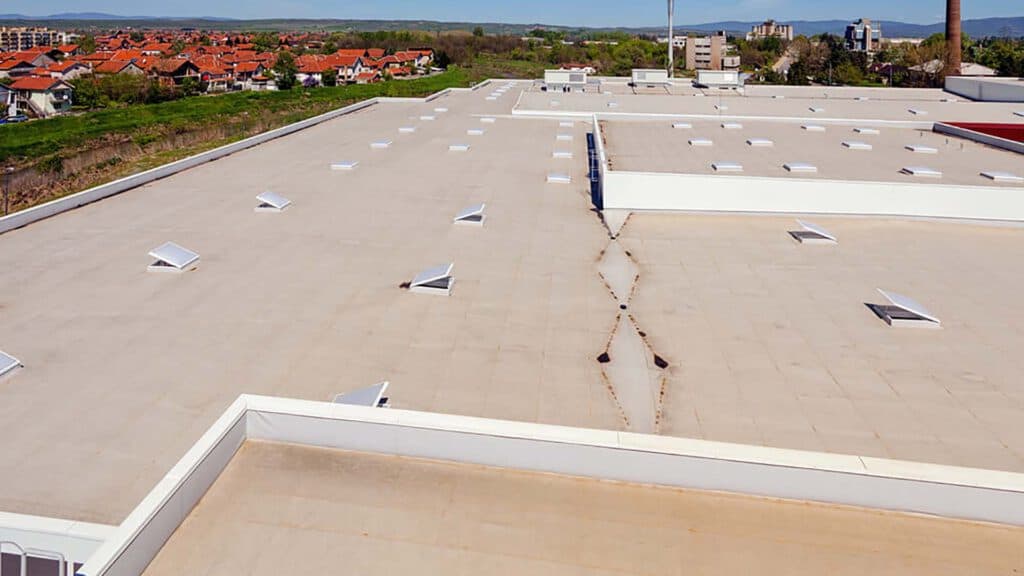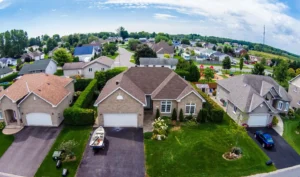A commercial roofing system typically is any type of roof over a commercial building such as a mall, store, or residential multi-family property. They function with the same goals as a residential roof but use various materials and methods that are very different. Take a look at some of the most common types of commercial roofing systems and when they may be ideal to use.

Metal Commercial Roof
Metal commercial roofing systems are durable and commonly used on large commercial buildings. creating a long lifespan in most cases. There are various formats used, such as coated stainless steel, metal tiles, galvanized steel, and aluminum.
It’s also a good option for fire resistance and sun reflectivity. In addition to this, metal roofs are good at keeping HVAC efficiencies top of the mind. They do require treatment to minimize the risk of corrosion over time. Costs can range from moderate to high.
BUR Commercial Roofing System
Built-up roofing, or BUR, is another common option. It usually involves covering the roof in tar and gravel, which creates a very strong and durable seal on the surface. This option is best for flat roofs. The layers are made up of reinforced felt and bitumen and can include cold-applied adhesives, tar, and asphalt.
These roofs are durable and are less likely to leak than others. They also offer good insulation. They can be a cost-effective choice, too.
EPDM Roofing System
Ethylene Propylene Diene Terpolymer (EPDM) is another commercial roofing option. It’s a type of rubber roof noted for its rubber membrane. This type of roof is UV ray resistant, which means it is able to help reduce energy costs significantly. It is also waterproof.
Costs for EPDM roofing tend to be a bit higher than other options, but it is long lasting and durable. The savings in energy costs is often the best benefit of this roofing solution.

PVC (Polyvinyl Chloride)
Polyvinyl chloride (PVC) is a reliable type of roofing material for commercial properties as well. This option is most beneficial because it keeps costs very low. It is also easy to source. In some regions, it is the best option because it is more resistant to higher winds. PVC isn’t always the most attractive option, and it may not last as long as other options, but it has grown in popularity in recent years.
Single-Ply Membrane (TPO)
Also known as thermoplastic polyolefin (TPO), the single-ply membrane is by far the most commonly used commercial roofing material. It is very affordable to install, which is why many choose it. However, there are other benefits, too. For example, it can be installed over the top of other types of surfaces, which makes it a good fit for most flat roofs. It has strong air-welded seams, which make it resistant to both fire and high winds. It is also typically good for all weather conditions.
Green Roofs
A newer option in terms of regular use, green roofs are a solid choice for many buildings. They provide a number of benefits, including providing good insulation qualities from the sun to reduce energy costs. They can also be a great sustainability option for some. Unlike other roofs, though, there is a significant amount of increased maintenance and upkeep with green roofs that make them more difficult for some uses.
Modified Bitumen Roofing (MB)
Sometimes just called MB, modified bitumen roofing is made up of asphalt. It is a good option for those seeking a reliable, long-term solution for a low slope or flat roof. It offers good insulation benefits and tends to be waterproof. The modified bitumen membranes are made in a factor and often have a polyester or fiberglass reinforcement added to them. They can also be UV ray protectant depending on the type selected.
While a good choice overall, these roofing systems tend to require careful installation to get it just right. It can be a bit more expensive for some applications as well.
Asphalt Shingle Roofing
Some commercial buildings do well with simple asphalt shingle roofing, a common option for residential properties. It can work for those with sloped roofs. These are the most affordable option on the market when it comes to sloped roofing materials.
They do not last as long as other options, generally peaking at around 10 to 15 years. However, they still provide lots of versatility in colors and features that make them an attractive option. They also do not do as well in extreme weather conditions.
Liquid Roofing
Liquid roofing is a less common option, but it can work well for many commercial roofing needs. The material goes on in a liquid form and works to eliminate problems like cracking or leaking, common with other forms. It is energy efficient and can last a long time. It can also be a very environmentally friendly option depending on the type. Overall, it is not as expensive as other types of roofing.
The key here is that liquid roofs are not a very attractive option. There are a few ways to dress them up or make them look special. If that matters, this may not be the right choice.
Spray Polyurethane Foam
Spray Polyurethane Foam (SPF) is another type of roofing option. This option is the most energy efficient way to cover the commercial building. These work to deliver thermal protection, and they are great for moisture and air protection as well. These are a cost efficient and efficient solution because they do not have any seams to them.
SPF roofs last 10 to 20 years and offer such good efficiency that it can make heating and air conditioning more affordable. The installation process is not hard, but it can be more difficult and requires a professional. Installation cannot occur when there is ice, frost, or any surface moisture.
Finding the Right Option
It is important to take into consideration factors like budgets and aesthetics. However, choosing the right commercial roofing system often focuses around selecting a system that provides the highest level of protection for your objectives and goals. Comparing a few of these options may help make it easier to find the best overall solution.





